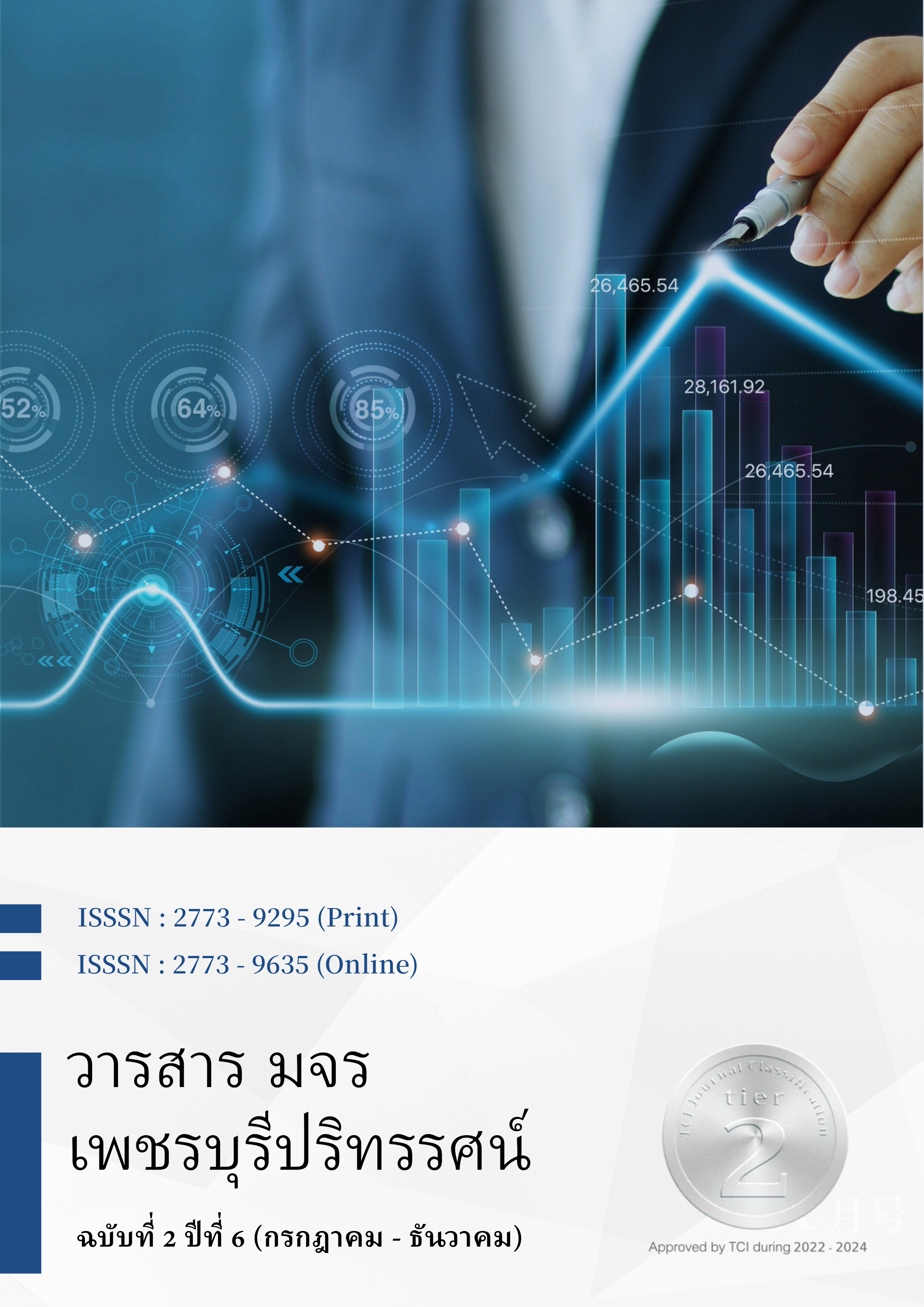STRATEGIES FOR DRIVING AND DEVELOPMENT OF COMPUTATIONAL THINKING SKILLS OF STUDENTS IN BANNONGBOUY SCHOOL UNDER PHETCHABURI PRIMARY EDUCATIONAL SERVICE AREA OFFICE 2
Main Article Content
Abstract
Global changes in the 21st century have focusing on developing skills in various areas, one of which is an important skill is problem-solving skills. using computational thinking skills can be used to solve problems step by step and systematically. The researcher conducted this research with the objectives of 1) to study strategies for driving development of computational thinking Skills. 2) to study strategies for development of computational thinking Skills. And 3) to study results of development of computational thinking Skills. The target group was 3 teachers and 45 grade 1-3 students. The tools used in this research were:
a manual strategies for driving and development of computational thinking skills of students. Quiz measurement computational thinking Skills of students before and after use strategies for driving development of computational thinking Skills of students and Interview form for research. Instrument consistency the value is between 0.67 - 1.00. Quantitative data analysis was statistical, arithmetic mean, progress percentage, standard deviation.
The results of this research were as follows: 1) Strategies used in driving of computational thinking skills of students in Bannongbouy School under Phetchaburi Primary Educational Service Area Office 2. There are 3 strategies: Participation Strategy, Empowerment strategy and Integration strategy. 2)Strategies used by teachers development of computational thinking Skills of students is the LIPP strategy, consisting of 4 steps: Learning , Ideas , Plan and Piece and Estimate. 3) The results of developing computational thinking skills before and after the use of strategies for driving and development of computational thinking skills of students in Bannongbouy School under Phetchaburi Primary Educational Service Area Office 2 it was found that mean before used the strategy was 8.07 the standard deviation was 1.77 and mean after used the strategy was 16.42 the standard deviation was 1.60 and progress percentage to 41.75 The results of the interviews for the opinions of teachers and students found that teachers and students have fun with the activities this handbook is a useful guide that can help developing computational thinking skills and can be further applied to learning in each subject and other activities as well. The findings of this research show that Teachers will be able to develop students with computational thinking skills to succeed. There must be a strategy for drive every strategy together according to the plan set out.
Article Details

This work is licensed under a Creative Commons Attribution-NonCommercial-NoDerivatives 4.0 International License.
References
โชติกา สงคราม. การวิจัยเชิงปฏิบัติการเพื่อพัฒนาการเรียนรู้แบบใช้ปัญหาเป็นฐานที่ส่งเสริมทักษะการคิดเชิงคำนวณ เรื่อง ความน่าจะเป็นของนักเรียนชั้นมัธยมศึกษาปีที่ 4. การค้นคว้าอิสระ ปริญญาการศึกษามหาบัณฑิต มหาวิทยาลัยนเรศวร.
นงนุช เอกตระกูล. (2558). การพัฒนาการจัดการเรียนรู้แบบ STEM เพื่อเพิ่มผลสัมฤทธิ์ทางการเรียนและความสามารถในการคิดแก้ปัญหาอย่างสร้างสรรค์ (CPS) ของนักเรียนชั้นประถมศึกษาปีที่ 6.
โรงเรียนอัสสัมชัญธนบุรี.
นัสรินทร์ ลือชา. (2557). ผลการจัดการเรียนรู้ตามแนวสะเต็มศึกษา (STEM Education) ที่มีต่อผลสัมฤทธ์ทางการศึกษา ชีววิทยา ความสามารถในการแก้ปัญหาและความพึงพอใจต่อการจัดการเรียนรู้ของนักศึกษาชั้นมัธยมศึกษาปีที่ 5. วิทยานิพนธ์ศึกษาศาสตร์มหาบัณฑิต, มหาวิทยาลัยสงขลานครินทร์.
บุญยง ทับทอง. (2559). กลยุทธ์การขับเคลื่อนการพัฒนาคุณภาพการอ่านของนักเรียนโรงเรียนอนุบาลเพชรบุรี. วิทยานิพนธ์ครุศาสตร์มหาบัณฑิต สาขาการบริหารการศึกษา คณะครุศาสตร์ มหาวิทยาลัยราชภัฏเพชรบุรี.
เพชรลดา อาจขาว. (2563). กลยุทธ์การขับเคลื่อนและการพัฒนาทักษะการคิดแก้ปัญหาของนักเรียนกลุ่มโรงเรียนเครือข่ายบ้านโป่ง 2 สังกัดสำนักงานเตพื้นที่การศึกษาประถมศึกษาราชบุรี เขต 2. วิทยานิพนธ์ครุศาสตร์มหาบัณฑิต สาขาการบริหารการศึกษา คณะครุศาสตร์ มหาวิทยาลัยราชภัฏเพชรบุรี.
ยุรนันท์ วรรณรักษ์. (2562). กลยุทธ์การขับเคลื่อนและการพัฒนาทักษะการฟังและการพูดภาษาอังกฤษของนักเรียนในสถานศึกษา สังกัดสำนักงานเขตพื้นที่การศึกษาประถมศึกษาประจวบคีรีขันธ์ เขต 2. วิทยานิพนธ์ครุศาสตร์มหาบัณฑิต สาขาการบริหารการศึกษา คณะครุศาสตร์ มหาวิทยาลัยราชภัฏเพชรบุรี.
สถาบันส่งเสริมการสอนวิทยาศาสตร์และเทคโนโลยี. (2559). สะเต็มศึกษา (STEM Education). กรุงเทพฯ: สถาบันส่งเสริมการสอนวิทยาศาสตร์และเทคโนโลยี.
สถาบันส่งเสริมวิทยาศาสตร์และเทคโนโลยี กระทรวงศึกษาธิการ. (2560). คู่มือการใช้หลักสูตรรายวิชาพื้นฐานวิทยาศาสตร์ กลุ่มสาระการเรียนรู้วิทยาศาสตร์ (ฉบับปรับปรุง พ.ศ. 2561) ระดับประถมศึกษาและมัธยมศึกษา. กรุงเทพฯ. สถาบันส่งเสริมการสอนวิทยาศาสตร์และเทคโนโลยี.
สถาบันส่งเสริมวิทยาศาสตร์และเทคโนโลยี กระทรวงศึกษาธิการ.(2561). คู่มือการใช้หลักสูตรรายวิชาพื้นฐานวิทยาศาสตร์ กลุ่มสาระการเรียนรู้วิทยาศาสตร์ (ฉบับปรับปรุง พ.ศ. 2561) ระดับประถมศึกษาและมัธยมศึกษา. กรุงเทพฯ. สถาบันส่งเสริมการสอนวิทยาศาสตร์และเทคโนโลยี.
สุภาพร สะอาดนัก. (2560). กลยุทธ์การขับเคลื่อนและการพัฒนาคุณธรรมของนักเรียนโรงเรียนบ้านหนองปืนแตก สังกัดสำนักงานเขตพื้นที่การศึกษาประถมศึกษาเพชรบุรี เขต 2. วิทยานิพนธ์ครุศาสตร์มหาบัณฑิต สาขาการบริหารการศึกษา คณะครุศาสตร์ มหาวิทยาลัยราชภัฏเพชรบุรี.
สำนักงานวิชาการและมาตรฐานการศึกษา. (2561). มาตรฐานการศึกษาของชาติ พ.ศ.2561.กรุงเทพฯ : บริษัท 21 เซ็นจูรี่จำกัด
อนันต์ ม่วงอุมิงค์. (2560). กลยุทธ์การขับเคลื่อนการพัฒนาคุณลักษณะอันพึงประสงค์ของนักเรียนมุสลิม โรงเรียนพัฒนศาสน์วิทยาท่าแร้ง จังหวัดเพชรบุรี. วิทยานิพนธ์ครุศาสตร์ดุษฎีบัณฑิต สาขาการบริหารการศึกษา คณะครุศาสตร์ มหาวิทยาลัยราชภัฏเพชรบุรี.
อาทร นกแก้ว และสุภารัตน์ เชื้อโชติ. (2563). ความรู้เนื้อหาผสานวิธีสอนการคิดเชิงนามธรรมสำหรับการคิดเชิงคำนวณ. วารสารศึกษาศาสตร์มหาวิทยาลัยสงขลานครินทร์ วิทยาเขตปัตตานี,
(3) : กันยายน - ธันวาคม 2563.
Scott,C. (2012). An Investigation of Science, Technology, Engineering and Mathematics (STAM) Focused High school in the U.S. Journal of STAM Education, 13(5): 30-39.
Shields,E. (2006). Engineering our future new Jersey elementary school. Retrieved October14,2017, From http://www.ciese.org/papers/2006/ASEE_paper_G.doc.


